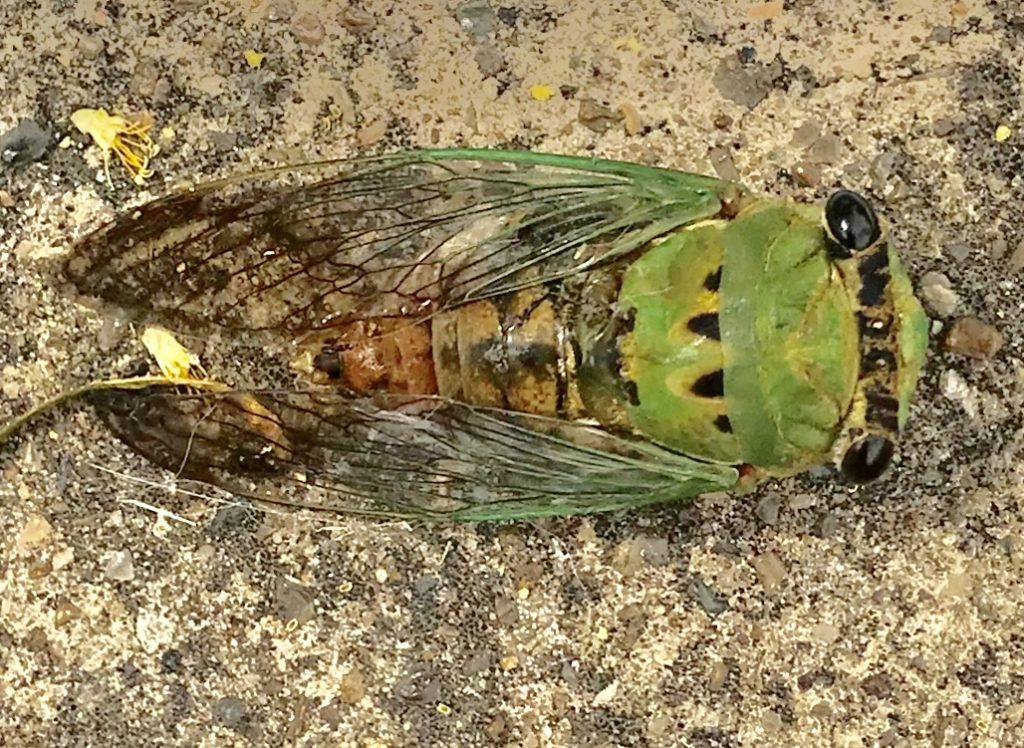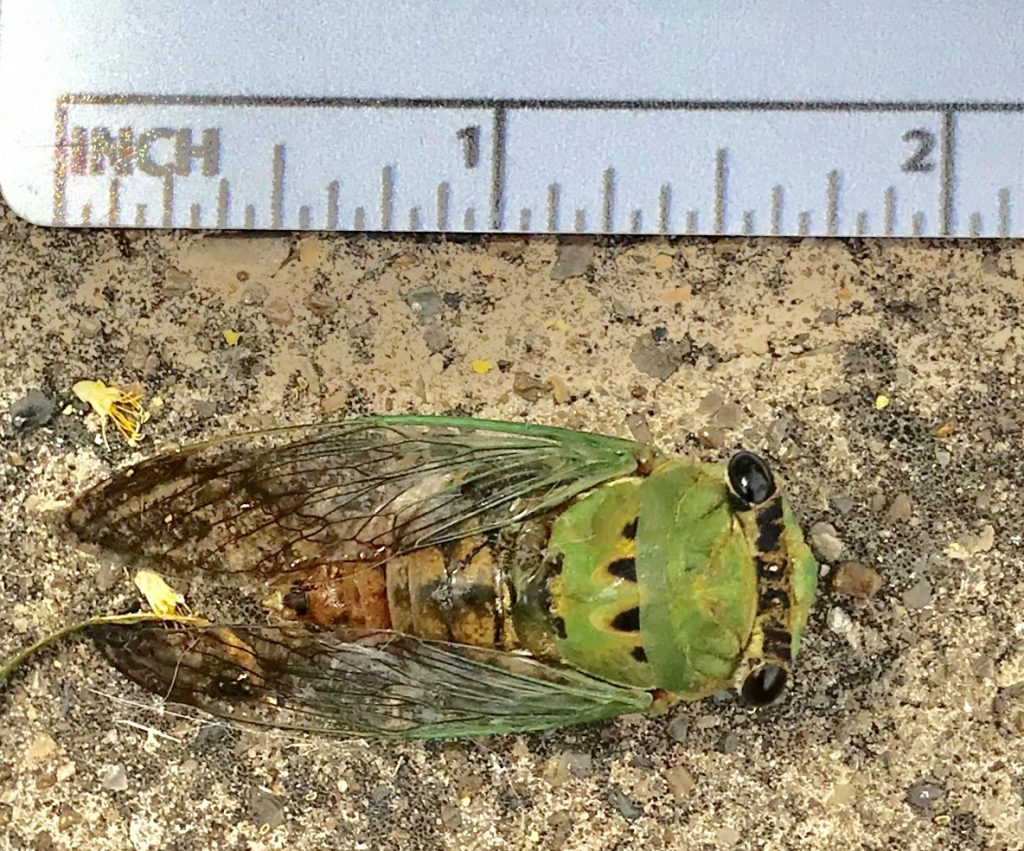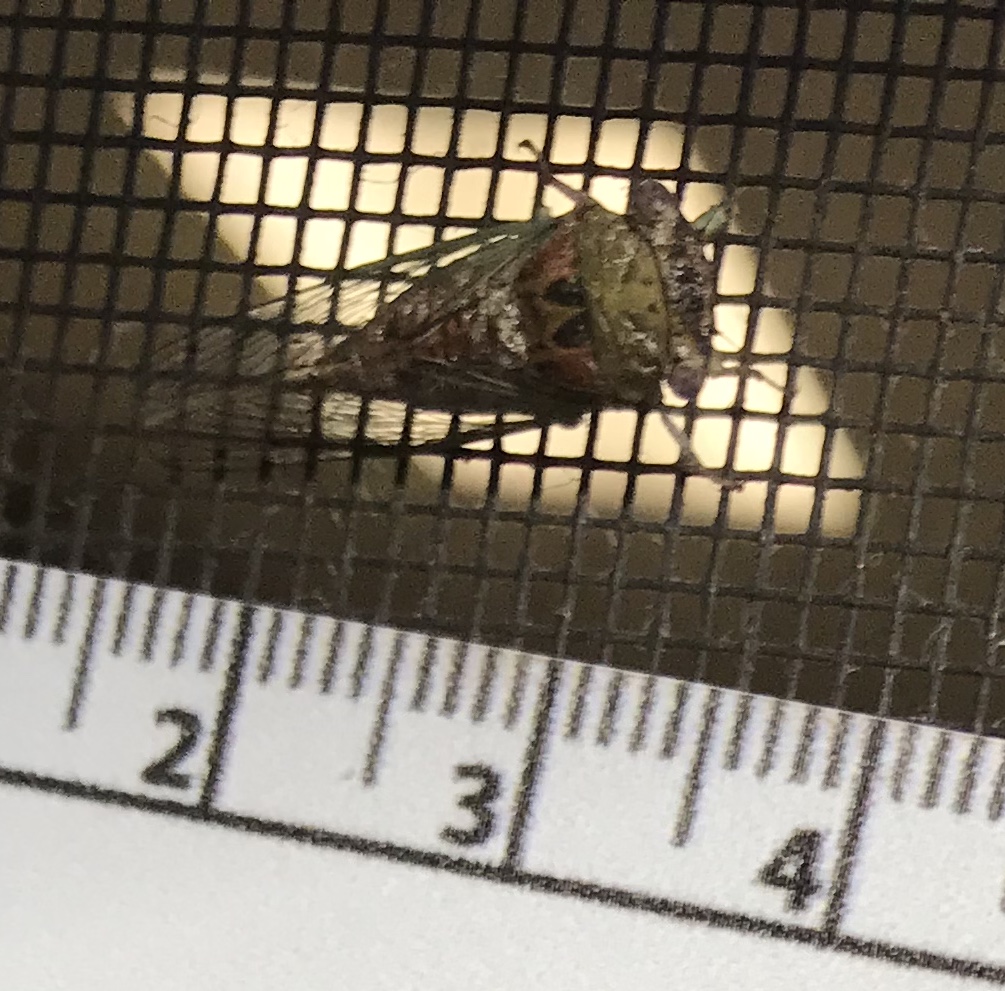Not the weather — the cicada — Superb Dog-day Cicada, Neotibicen superbus


Listening to night songs was a wonderful aspect of growing up Kansas. Prior to the onslaught of air conditioning, old, two-and-a-half-story wooden homes had huge attic fans that pulled a breeze into upper-story bedroom windows — most nights. Other nights, especially airless nights that followed the shimmering dog days of summer, the breeze was stilled — but the darkness was not.
The lyrical noise of cicadas kept many a child company on those oppressively sleepless nights. A “rapid clacky-clicking crescendo and fall” describes the song of the Superb Dog-day Cicada, according to this Website: http://www.insectsingers.com/ — where you also can listen to cicada songs from other parts of the world, like Borneo, New Zealand, Japan, India, and points beyond.
Mornings, back when I was a child, were busy with rounding up cicada shells to show mom. It was a rare treat to see the cicada — that’s when you had to pull mom by the arm to show her your find — picking up a cicada caused a frenetic buzzing that tickled the hand — thus eliciting a quick squeal and release!

The Superb Dog-day Cicada has been found in much of Texas and Oklahoma, west Arkansas, southwest Missouri, southeast Kansas and possibly east New Mexico and northwest Louisiana.
It’s only a name
“The dog days or dog days of summer are the hot, sultry days of summer. They were historically the period following the heliacal rising of the star system Sirius*, which Greek and Roman astrology connected with heat, drought, sudden thunderstorms, lethargy, fever, mad dogs, and bad luck.” (Wikipedia)
*“Sirius marks the nose of Canis Major, the Greater Dog. … The first sighting of Sirius and its association with the rebirth of the Nile was so important that its heliacal rising marked the start of the Egyptian calendar year. Heliacal relates to the star’s proximity to the Sun (Helios in Greek).” https://www.skyandtelescope.com/observing/a-real-scorcher-sirius-at-heliacal-rising/
How does all that cosmological tradition relate to our pretty olive-green and amber cicada with the iridescent wings? It’s really just happenstance: It’s thought that the Superb Dog-day Cicada is so named because it makes its annual appearance during the dog days of summer — when it is most hot and humid — coinciding with the time when Sirius, the Dog Star, rises at the same time as the sun.
Wikipedia, always fascinating, on the ancient cicada:
“. . . extant (currently existing) species occur all around the world in temperate to tropical climates. They typically live in trees, feeding on watery sap from xylem tissue (the water conducting tissue of vascular plants) and laying their eggs in a slit in the bark.
“Most cicadas are cryptic (ability to avoid observation or detection), singing at night to avoid predators. The periodic cicadas spend most of their lives as underground nymphs, emerging only after 13 or 17 years, which may reduce losses by starving their predators and eventually emerging in huge numbers that overwhelm and satiate any remaining predators.
“The annual cicadas are species that emerge every year. Though these cicada have lifecycles that can vary from one to nine or more years as underground larvae, their emergence above ground as adults is not synchronized, so some appear every year.
“Cicadas have been featured in literature since the time of Homer‘s Iliad, and as motifs in art from as far back as the Chinese Shang dynasty. They have also been used in myths and folklore to represent carefree living and immortality.”
In art, “the cicada has been seen as a symbol of resurrection, an association that owes to its fascinating life cycle.” In two and three dimensional art, it has been used as an “analogy for the spirits of the dead rising on a path to eternal existence in a transcendent realm.” — https://www.freersackler.si.edu/cicadas/
There are more than 190 varieties (including species & subspecies) of cicadas in North America, and more than 3,390 varieties of cicadas around the world. This number grows each year as researchers discover and document new species.
Cicadas exist on every continent but Antarctica. They are a superfamily of insects in the
The dog-day cicadas are not a plant pest in Texas, according to Texas AgriLife Extension Service. Adult dog-day cicadas live five to six weeks — plenty of time to listen to their songs.
There’s more — or in this case, less — less cicada — as in a tiny form. One morning I noticed something on a window screen. The measuring tool is in centimeters. This tiny cicada is three-quarters of an inch long from nose to tip of wings. Its name: Little Mesquite Cicada, Pacarina puella.a

On another morning, a Little Mesquite Cicada resting on the lid of the trash bin.

Other interesting websites helpful in writing this blog post were: Dave’s Garden, Bugguide and (Texas Insects) tamu.edu
As always, fascinating blog post!
Thank you! It’s a fascinating world — every time we step outdoors, it seems there’s something to wonder about!
Especially enjoyed this post. Remembering my pre-A/C childhood in Indiana. Cicadas are interesting creatures.
Thank you. And yeah! There’s nothing like that experience — pre-a/c, hot summer nights, cicada lullaby, simpler times . . . .
After moving to the RGV in 2017 I had my first experience with Cicada’s life cycle. Their transformation is incredible, and this is good to read about their history. Thanks Anita!
Incredible, yes. Glad you’re experiencing this part of the world! Stay tuned, you never know what will beckon next from beyond the air-conditioned walls. I had no idea we had wee cicadas.